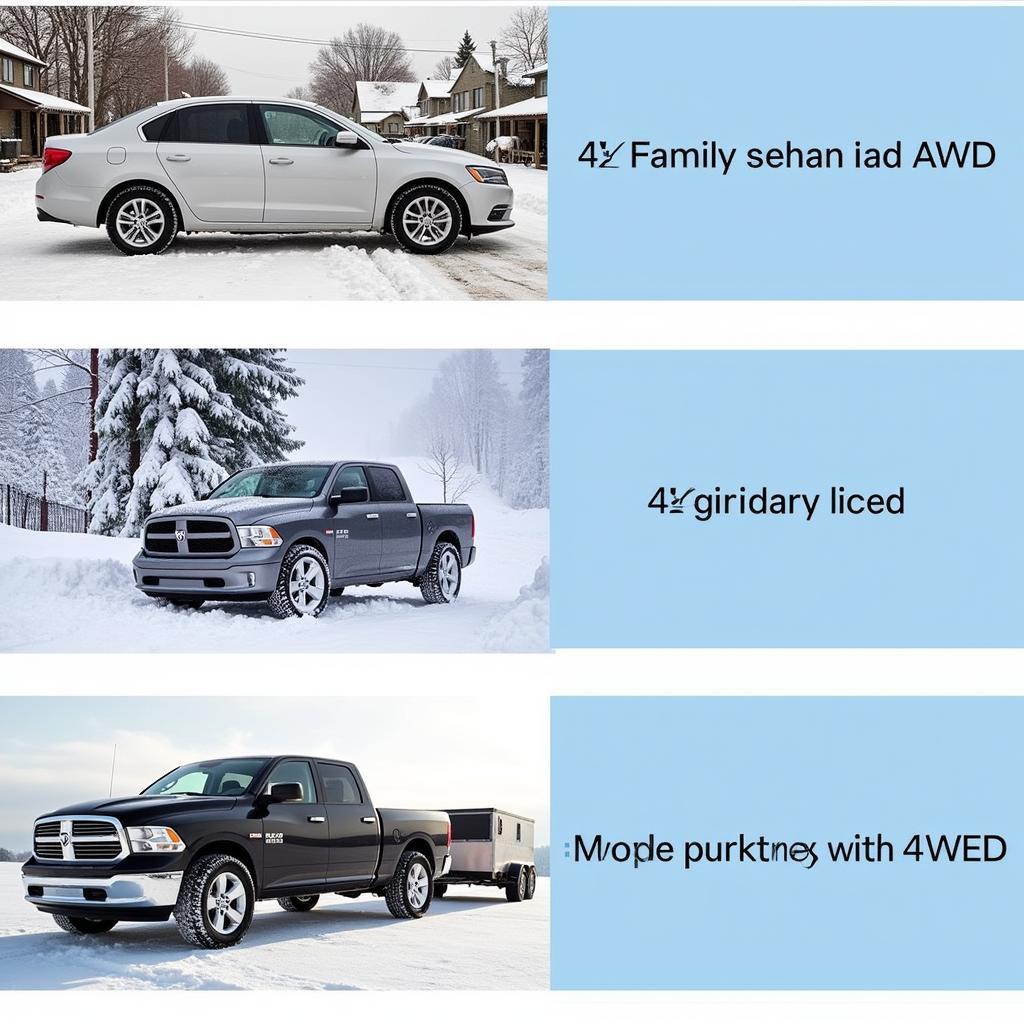Awd Vs 4wd In Snow And Ice is a common question for drivers living in colder climates. Choosing the right drivetrain can significantly impact your safety and performance during winter driving. This article will delve into the mechanics of each system, comparing their strengths and weaknesses to help you make an informed decision.
Understanding All-Wheel Drive (AWD)
AWD systems are designed to provide power to all four wheels, either permanently or on demand. This can improve traction in various conditions, including snow and ice. However, not all AWD systems are created equal. Some prioritize fuel efficiency by sending power primarily to the front or rear wheels until slippage is detected. Others distribute power more evenly, offering better proactive traction.
How AWD Performs in Snow and Ice
AWD can offer significant advantages in light to moderate snow and icy conditions. The power distribution helps prevent wheelspin and maintains stability. However, AWD systems often lack the low-range gearing found in some 4WD systems, making them less effective in deep snow or on steep, icy inclines.
Exploring Four-Wheel Drive (4WD)
4WD systems are typically found in trucks and SUVs designed for off-roading. These systems provide power to all four wheels, similar to AWD. However, 4WD usually includes a low-range gear setting for enhanced torque at low speeds, ideal for navigating challenging terrain like deep snow or mud. Additionally, some 4WD systems allow the driver to manually lock the front and rear differentials, further improving traction in extreme conditions.
4WD Performance on Snow and Ice
4WD excels in heavy snow and ice due to its robust power delivery and low-range gearing. The ability to lock differentials ensures maximum traction by forcing all wheels to rotate at the same speed, even if one or more tires lose contact with the surface. However, 4WD can be less fuel-efficient than AWD and can feel less refined on dry pavement.
AWD vs 4WD: A Head-to-Head Comparison
To understand the key differences, let’s compare AWD and 4WD side-by-side:
| Feature | AWD | 4WD |
|---|---|---|
| Power Distribution | Automatic, variable | Manual or automatic, often full-time |
| Low-Range Gearing | Typically absent | Usually present |
| Differential Lock | Typically absent | Often available |
| Fuel Efficiency | Generally better | Generally lower |
| On-Road Handling | Generally smoother | Can feel less refined |
| Off-Road Capability | Limited | Superior |
Which Drivetrain is Right for You?
Choosing between AWD and 4WD depends on your specific needs and driving conditions. If you primarily drive on paved roads and encounter light to moderate snow and ice, AWD is likely sufficient. If you frequently drive in deep snow, off-road, or require maximum traction in challenging winter conditions, 4WD is the better choice.
 Choosing the Right Drivetrain for Winter
Choosing the Right Drivetrain for Winter
Frequently Asked Questions (FAQs)
-
Is AWD better than 4WD in ice? Not necessarily. While AWD provides good traction on ice, 4WD with locked differentials offers superior grip in extreme icy conditions.
-
Can I leave my 4WD engaged all the time? Generally, it’s not recommended to use 4WD on dry pavement, as it can strain the drivetrain.
-
Is AWD good for everyday driving? Yes, AWD is generally suitable for everyday driving, offering improved traction and stability in various conditions.
Need More Help?
For further assistance, please contact us at Phone: 0372999888, Email: [email protected] or visit us at 236 Cầu Giấy, Hanoi. Our customer service team is available 24/7.